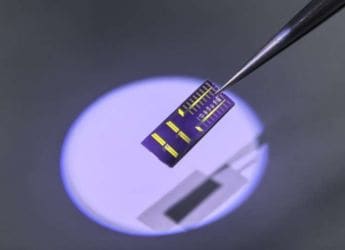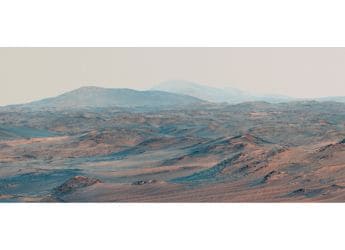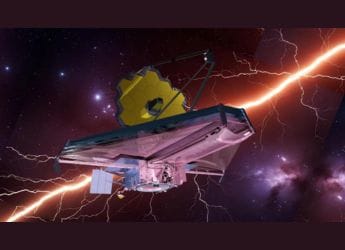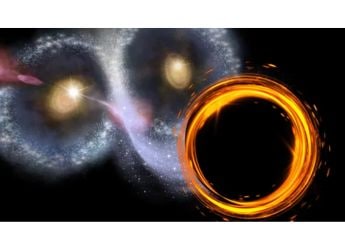- Home
- Science
- Science News
- NASA’s JWST Produces First Ever 3D Map of Distant Planet WASP 18b
NASA’s JWST Produces First-Ever 3D Map of Distant Planet WASP-18b
NASA’s James Webb Space Telescope produced the first 3D atmospheric map of exoplanet WASP-18b, an ultra-hot Jupiter 400 light-years away.

Photo Credit: NASA/JPL-Caltech (K. Miller/IPAC
An artist's representation of WASP-18b, an exoplanet some 400 light-years from Earth.
In a landmark achievement, astronomers have used NASA's James Webb Space Telescope (JWST) to produce the first-ever three-dimensional map of a planet outside our solar system. The target was WASP-18b, an “ultra-hot Jupiter” about 400 light-years from Earth. Using JWST's infrared spectrograph, the team created the map via a technique called 3D eclipse mapping. It reveals a blazing dayside hotspot so extreme that water vapour is breaking apart.
Mapping the atmosphere in 3D
According to the paper, the team used spectroscopic “eclipse mapping.” As WASP-18b passed behind its star, JWST's near-infrared imager (NIRISS) recorded tiny dips in multiple wavelengths. Each wavelength probes a different atmospheric layer, letting scientists assemble a 3D temperature profile. Mapping at a water-absorbing wavelength shows the planet's “water deck,” while a non-absorbing wavelength probes deeper.
“This method allows us to image exoplanets that we can't see directly, because their host stars are too bright,” said lead author Ryan Challener. With JWST's sensitivity, the team could reveal WASP-18b's thermal structure in unprecedented detail.
Scorching heat breaks down water
WASP-18b is a gas giant about 10 times the mass of Jupiter, orbiting its star every 23 hours. Its tidally locked orbit means one face is always scorched by starlight, reaching roughly 2,760 °C (5,000 °F). The JWST map shows a bright central “hotspot” where light is most intense, surrounded by a cooler ring. Notably, the hotspot contains much less water vapor than average – evidence that “it's starting to break down the water,” Challener said. This direct 3D observation confirms theoretical predictions, and the researchers say the method can now be used to study other worlds “in 3D as a population”.
Get your daily dose of tech news, reviews, and insights, in under 80 characters on Gadgets 360 Turbo. Connect with fellow tech lovers on our Forum. Follow us on X, Facebook, WhatsApp, Threads and Google News for instant updates. Catch all the action on our YouTube channel.
Related Stories
- Samsung Galaxy Unpacked 2025
- ChatGPT
- Redmi Note 14 Pro+
- iPhone 16
- Apple Vision Pro
- Oneplus 12
- OnePlus Nord CE 3 Lite 5G
- iPhone 13
- Xiaomi 14 Pro
- Oppo Find N3
- Tecno Spark Go (2023)
- Realme V30
- Best Phones Under 25000
- Samsung Galaxy S24 Series
- Cryptocurrency
- iQoo 12
- Samsung Galaxy S24 Ultra
- Giottus
- Samsung Galaxy Z Flip 5
- Apple 'Scary Fast'
- Housefull 5
- GoPro Hero 12 Black Review
- Invincible Season 2
- JioGlass
- HD Ready TV
- Laptop Under 50000
- Smartwatch Under 10000
- Latest Mobile Phones
- Compare Phones
- OnePlus 15R
- Realme Narzo 90x 5G
- Realme Narzo 90 5G
- Vivo S50 Pro Mini
- Vivo S50
- OPPO Reno 15c
- Redmi Note 15 5G
- Redmi Note 15 Pro 5G
- Asus ProArt P16
- MacBook Pro 14-inch (M5, 2025)
- Infinix Xpad Edge
- OnePlus Pad Go 2
- OnePlus Watch Lite
- Just Corseca Skywatch Pro
- Acerpure Nitro Z Series 100-inch QLED TV
- Samsung 43 Inch LED Ultra HD (4K) Smart TV (UA43UE81AFULXL)
- Asus ROG Ally
- Nintendo Switch Lite
- Haier 1.6 Ton 5 Star Inverter Split AC (HSU19G-MZAID5BN-INV)
- Haier 1.6 Ton 5 Star Inverter Split AC (HSU19G-MZAIM5BN-INV)

















